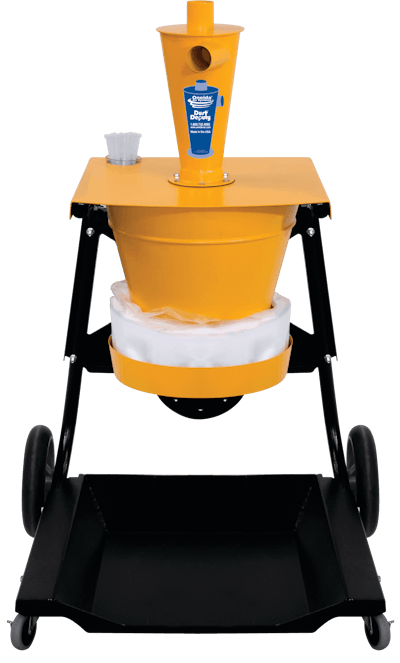
Grinding concrete will do a number on your gear. It’s the nature of the beast. One of the most frustrating aspects of project management can be unexpected hiccups with your dust extraction equipment. This is especially true now that you’re required to comply with the OSHA silica dust standard. There’s nothing worse than having a goal time thwarted because your extractor is constantly losing suction power. Believe it or not, there’s a way to avoid this time sucking situation. Enter the pre-separator—a simple accessory that can improve extractor’s performance, giving you longer run times and better chances of staying on schedule.
How Does it Work?
Just like the name implies, a pre-separator hooks up to your extractor and separates a majority—from 80-97%—of incoming concrete dust into an attached waste container. As a result, only a small percentage of material passes via the airstream to your extractor and its filter. Without a pre-separator, a dust extractor’s suction power begins to rapidly decline within a few minutes, as its filter is exposed to more and more material. By adding a pre-separator, the filter clogging process is significantly slowed, allowing for more consistent airflow over longer periods of time. The cleaner your filter stays, the longer your extractor can operate at peak efficiency. Faster cleanup can be a game changer for project completion times.
Equally appealing is the cost savings. Dust extractor filters can be expensive to replace. By prolonging filter life, a pre-separator can pay for itself in a few short weeks.
Another advantage of using a pre-separator—one that is often overlooked—is increased waste capacity. You’re no longer limited to what your extractor can hold. Depending on the size of the container it’s paired with, a pre-separator can easily multiply the amount of material you’re able to collect at one time.
Choosing a Pre-Separator
There are several different factors contractors should consider before choosing a pre-separator, such as design, containment options, and mobility.
A cyclone is the most efficient type of pre-separator. Its conical design uses centrifugal force to spin debris out of the airstream and down to the waste container below. As a result, only a small portion of material rises through the “eye” of the cyclone and out to the extractor. If you want to achieve the highest percentage of pre-separation possible, a cyclone is your best bet.
If equipment height is a concern, you may want to consider a pre-separator head, which has a much lower profile and usually consists of an inlet and outlet stacked atop a flat disc. Unfortunately, the squat form of these types of pre-separators make them less efficient than cyclones; so you’ll notice more material passing through to your extractor.
Another consideration should be the type and capacity of the waste container you’ll be using with the pre-separator. The market offers a variety of choices from Longopac bags to your typical steel drum. For a lot of contractors, it often comes down to the size of the job. If you deal with large volumes of material, you may want to opt for a 55 gallon steel drum over a Longopac compatible unit.
A pre-separator’s ease of mobility should be considered as well. If you’re a one person operation, a steel drum without a dolly may not be the best choice. Many Longopac units, like Oneida Air’s CDD-L Pre-Separator (available at oneida-air.com), are sold with a wheeled cart, allowing you to easily roll your way through a worksite. If you’re leaning towards a mobility cart, make sure it’s equipped with locking casters. You don’t want to waste your time chasing a piece of equipment.
Know Your Hose
When it comes to grinding concrete, all hoses are not created equal. Working with the wrong hose is a serious risk to contractor safety, as it increases risk of electric shock. As material moves through a hose, it creates a positive charge. The charge continues to build up until it is released, which is the moment a shock occurs. This is much, much more severe than the shock one might experience from touching a metal door knob or walking on carpet. Such a shock can cause serious burns and even cardiac arrest. It is for this reason that static dissipative or conductive hose is strongly recommend for use with any equipment attached to a grinder, including extractors and pre-separators.
It’s also important to be mindful of hose length. When using a pre-separator, the general rule of thumb for hoses is the shorter, the better. It’s less restrictive on airflow. Ideally, you want no more than five to six feet of hose between the extractor and pre-separator. A few extra feet of hose will not have a noticeable effect on suction performance. It’s when you add 10 or 20 feet that you start to notice a difference. Sharp bends in hose should also be avoided, as they impede airflow and suction.
Troubleshooting
While a pre-separator can be quite the work horse for such a simple accessory, there are few common issues contractors may encounter. Perhaps the most common experience is a sudden loss of suction. This is often caused by an air leak or decrease in pre-separation efficiency, which can occur anywhere in your setup, from a pinhole in a hose, to an improper seal between the pre-separator and its base. The simplest way to search out the leak is to perform a smoke test (kits are available at most hardware stores) while the extractor is running. A clogged filter on your extractor or a hose blockage will also impact suction strength. Cleaning or replacing your filter and clearing your hose of debris are sure fire ways to correct this issue.
If you want to increase the efficiency of your dust extractor and improve project times, adding a pre-separator is an quick and easy way to beat the grind.
Ed. Note: Michelle Kelley is Advertising and PR Manager for Oneida Air Systems.



















